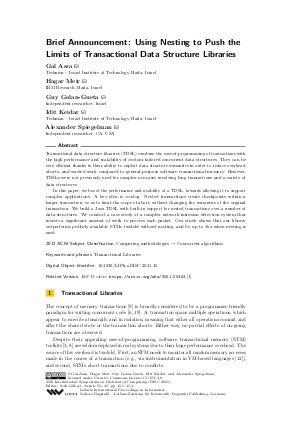Brief Announcement: Using Nesting to Push the Limits of Transactional Data Structure Libraries
Authors Gal Assa, Hagar Meir, Guy Golan-Gueta, Idit Keidar, Alexander Spiegelman
-
Part of:
Volume:
35th International Symposium on Distributed Computing (DISC 2021)
Part of: Series: Leibniz International Proceedings in Informatics (LIPIcs)
Part of: Conference: International Symposium on Distributed Computing (DISC) - License:
 Creative Commons Attribution 4.0 International license
Creative Commons Attribution 4.0 International license
- Publication Date: 2021-10-04
File

PDF
LIPIcs.DISC.2021.45.pdf
- Filesize: 392 kB
- 4 pages
Document Identifiers
Related Versions
- Full Version https://arxiv.org/abs/2001.00363
Subject Classification
ACM Subject Classification
- Computing methodologies → Concurrent algorithms
Keywords
- Transactional Libraries
Metrics
- Access Statistics
-
Total Accesses (updated on a weekly basis)
0Document
0Metadata
Abstract
Transactional data structure libraries (TDSL) combine the ease-of-programming of transactions with the high performance and scalability of custom-tailored concurrent data structures. They can be very efficient thanks to their ability to exploit data structure semantics in order to reduce overhead, aborts, and wasted work compared to general-purpose software transactional memory. However, TDSLs were not previously used for complex use-cases involving long transactions and a variety of data structures. In this paper, we boost the performance and usability of a TDSL, towards allowing it to support complex applications. A key idea is nesting. Nested transactions create checkpoints within a longer transaction, so as to limit the scope of abort, without changing the semantics of the original transaction. We build a Java TDSL with built-in support for nested transactions over a number of data structures. We conduct a case study of a complex network intrusion detection system that invests a significant amount of work to process each packet. Our study shows that our library outperforms publicly available STMs twofold without nesting, and by up to 16x when nesting is used.
Cite As Get BibTex
Gal Assa, Hagar Meir, Guy Golan-Gueta, Idit Keidar, and Alexander Spiegelman. Brief Announcement: Using Nesting to Push the Limits of Transactional Data Structure Libraries. In 35th International Symposium on Distributed Computing (DISC 2021). Leibniz International Proceedings in Informatics (LIPIcs), Volume 209, pp. 45:1-45:4, Schloss Dagstuhl – Leibniz-Zentrum für Informatik (2021)
https://doi.org/10.4230/LIPIcs.DISC.2021.45
BibTex
@InProceedings{assa_et_al:LIPIcs.DISC.2021.45,
author = {Assa, Gal and Meir, Hagar and Golan-Gueta, Guy and Keidar, Idit and Spiegelman, Alexander},
title = {{Brief Announcement: Using Nesting to Push the Limits of Transactional Data Structure Libraries}},
booktitle = {35th International Symposium on Distributed Computing (DISC 2021)},
pages = {45:1--45:4},
series = {Leibniz International Proceedings in Informatics (LIPIcs)},
ISBN = {978-3-95977-210-5},
ISSN = {1868-8969},
year = {2021},
volume = {209},
editor = {Gilbert, Seth},
publisher = {Schloss Dagstuhl -- Leibniz-Zentrum f{\"u}r Informatik},
address = {Dagstuhl, Germany},
URL = {https://drops.dagstuhl.de/entities/document/10.4230/LIPIcs.DISC.2021.45},
URN = {urn:nbn:de:0030-drops-148479},
doi = {10.4230/LIPIcs.DISC.2021.45},
annote = {Keywords: Transactional Libraries}
}
Author Details
References
- Gal Assa, Hagar Meir, Guy Golan-Gueta, Idit Keidar, and Alexander Spiegelman. Using nesting to push the limits of transactional data structure libraries. arXiv preprint, 2021. URL: http://arxiv.org/abs/2001.00363.
-
Nathan G Bronson, Jared Casper, Hassan Chafi, and Kunle Olukotun. A practical concurrent binary search tree. In ACM Sigplan Notices, volume 45. ACM, 2010.

-
Dave Dice, Ori Shalev, and Nir Shavit. Transactional locking II. In DISC. Springer, 2006.

-
Bart Haagdorens, Tim Vermeiren, and Marnix Goossens. Improving the performance of signature-based network intrusion detection sensors by multi-threading. In WISA. Springer, 2004.

-
Steve Heller, Maurice Herlihy, Victor Luchangco, Mark Moir, William N Scherer, and Nir Shavit. A lazy concurrent list-based set algorithm. In OPODIS. Springer, 2005.

-
Maurice Herlihy. The transactional manifesto: software engineering and non-blocking synchronization. In PLDI 2005. ACM, 2005.

-
Maurice Herlihy and Eric Koskinen. Transactional boosting: a methodology for highly-concurrent transactional objects. In PPoPP, 2008.

-
Maurice Herlihy, Victor Luchangco, Mark Moir, and William N Scherer III. Software transactional memory for dynamic-sized data structures. In PODC. ACM, 2003.

-
Maurice Herlihy and J Eliot B Moss. Transactional memory: Architectural support for lock-free data structures, volume 21. ACM, 1993.

-
Nathaniel Herman, Jeevana Priya Inala, Yihe Huang, Lillian Tsai, Eddie Kohler, Barbara Liskov, and Liuba Shrira. Type-aware transactions for faster concurrent code. In Eurosys, 2016.

- Guy Korland. Jstamp, 2014. URL: https://github.com/DeuceSTM/DeuceSTM/tree/master/src/test/jstamp.
-
Guy Korland, Nir Shavit, and Pascal Felber. Noninvasive concurrency with java STM. In MULTIPROG, 2010.

-
Pierre LaBorde, Lance Lebanoff, Christina Peterson, Deli Zhang, and Damian Dechev. Wait-free dynamic transactions for linked data structures. In PMAM, 2019.

-
Douglas Lea. Concurrent programming in Java: design principles and patterns. Addison-Wesley Professional, 2000.

-
Lance Lebanoff, Christina Peterson, and Damian Dechev. Check-wait-pounce: Increasing transactional data structure throughput by delaying transactions. In IFIP International Conference on Distributed Applications and Interoperable Systems. Springer, 2019.

-
Chi Cao Minh, JaeWoong Chung, Christos Kozyrakis, and Kunle Olukotun. STAMP: Stanford transactional applications for multi-processing. In 2008 IEEE International Symposium on Workload Characterization, 2008.

-
John Eliot Blakeslee Moss. Nested transactions: An approach to reliable distributed computing. Technical report, MIT Cambridge lab, 1981.

-
Yang Ni, Vijay S Menon, Ali-Reza Adl-Tabatabai, Antony L Hosking, Richard L Hudson, J Eliot B Moss, Bratin Saha, and Tatiana Shpeisman. Open nesting in software transactional memory. In PPoPP, 2007.

-
Michael Scott. Transactional memory today. SIGACT News, 46(2), 2015.

-
Nir Shavit and Itay Lotan. Skiplist-based concurrent priority queues. In IPDPS 2000. IEEE, 2000.

-
Alexander Spiegelman, Guy Golan-Gueta, and Idit Keidar. Transactional data structure libraries. In PLDI 2016. ACM, 2016.

-
Alexandru Turcu, Binoy Ravindran, and Mohamed M Saad. On closed nesting in distributed transactional memory. In Seventh ACM SIGPLAN workshop on Transactional Computing, 2012.

-
Deli Zhang, Pierre Laborde, Lance Lebanoff, and Damian Dechev. Lock-free transactional transformation for linked data structures. TOPC, 5(1), 2018.

